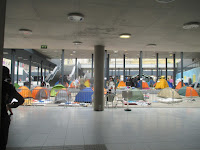Nearly
five years and six months have passed after the Great East Japan Earthquake. I
visited the quake-hit areas several times after the disaster. I traveled again
to the Sanriku coastal areas of Iwate prefecture, which were severely hit by
the tsunami disaster.
I
first visited Unosumai district in Kamaishi City, where more than 500 people
were killed or missing. The construction works are under way everywhere. The lands are being raised. (see also the 3rd photo from the top)
New school is being constructed.
Still, many temporally houses remain.
There are more new houses and shops built than November 2015, when I visited here last time. Rebuilding the hardware elements of infrastructure -- lands, roads and houses -- seems to be moving ahead.
Questions remain. Even if they build new residential areas, it is not sure whether people come back to live here. The future prospects of local communities and economic recovery are not clear.
New school is being constructed.
Still, many temporally houses remain.
There are more new houses and shops built than November 2015, when I visited here last time. Rebuilding the hardware elements of infrastructure -- lands, roads and houses -- seems to be moving ahead.
Questions remain. Even if they build new residential areas, it is not sure whether people come back to live here. The future prospects of local communities and economic recovery are not clear.
Traditional performing arts play important role.
I
attended one of the gatherings and talked with local people. We enjoyed Tiger Dance together (see the top photo)
The
situation of Otsuchi Town is similar.
The town hall was washed out by tsunami and many people, including the town manager, lost their lives.
The ruin of the town hall still stands. It is not determined whether to preserve the building as a monument or to clean it up.
The town hall was washed out by tsunami and many people, including the town manager, lost their lives.
The ruin of the town hall still stands. It is not determined whether to preserve the building as a monument or to clean it up.
The question of "yes, rebuilding hard infrastructure is going ahead, but redeveloping soft infrastructure is far behind" also remains here.
I visited a small garden at a side hill of a mountain. The “Bellgardia”
garden was developed and is owned privately by Mr. Itaru Sasaki.
He built a telephone box after the disaster.
The line is not connected. People come here to talk to the victims or to talk to themselves. It is called “the telephone of window” (see also the 2nd photo from the top)
He built a telephone box after the disaster.
The line is not connected. People come here to talk to the victims or to talk to themselves. It is called “the telephone of window” (see also the 2nd photo from the top)
He
also opened a micro library called “the liberally of the woods”. The
community’s children come here and read books.
The
place works as an information center and a gathering place of the
community. It is not open to the tourists.
Again, I have learned quite a lot in my visit to Iwate.
See also
Sendai, Ishinomaki@Tohoku; Sept 17-18, 2011
Save Iwate @ Morioka and Sanriku Coast (off Tokyo): May 10-11, 2014
3 years after the quake @ Iwate (off Tokyo) : May 10-11, 2014
Four and half years from the quake: Sanriku, Iwate: Oct. 31-Nov.1, 2015
Autumn Scenes @ Iwate Prefecture: Oct 31- Nov. 1, 2015
Traditional performing arts of Tohoku @ Zojoji Temple: March 12, 2016
Again, I have learned quite a lot in my visit to Iwate.
See also
Sendai, Ishinomaki@Tohoku; Sept 17-18, 2011
Save Iwate @ Morioka and Sanriku Coast (off Tokyo): May 10-11, 2014
3 years after the quake @ Iwate (off Tokyo) : May 10-11, 2014
Four and half years from the quake: Sanriku, Iwate: Oct. 31-Nov.1, 2015
Autumn Scenes @ Iwate Prefecture: Oct 31- Nov. 1, 2015
Traditional performing arts of Tohoku @ Zojoji Temple: March 12, 2016





















































